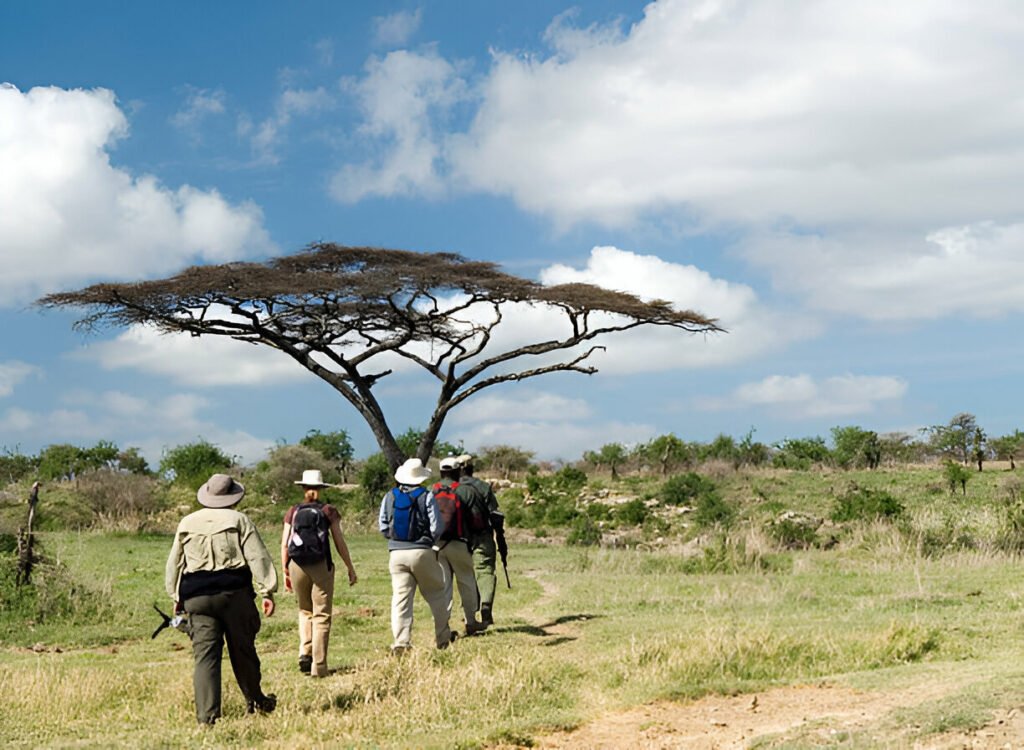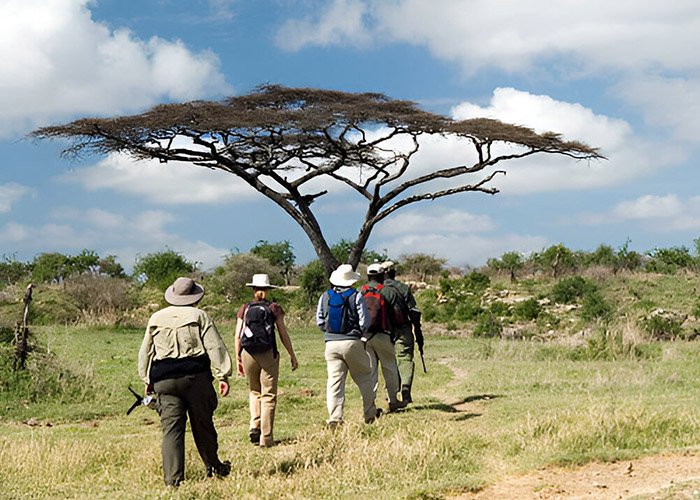
Imagine the thrill of tracking wildlife on foot, feeling the pulse of East Africa?s wilderness with every step. Welcome to the world of walking safaris? a safari experience like no other.
East Africa is a land of breathtaking landscapes, rich biodiversity, and some of the most iconic wildlife experiences in the world.
While game drives are the most common way to explore these natural wonders, walking safaris offer an intimate, immersive adventure that brings you closer to the wild in a deeply personal way.
Traversing these landscapes on foot allows you to engage with the environment at a pace that lets you truly absorb the sights, sounds, and smells of the African bush.
In this blog, we?ll explore why walking safaris are the ultimate adventure for nature enthusiasts, the unique experiences they offer, the top destinations in East Africa for such adventures, and essential tips to prepare for your journey.
Why Choose a Walking Safari in East Africa?

1. Immersive Experience
On foot, you become part of the landscape. The rustle of leaves underfoot, the earthy smell after a rainstorm, and the distant call of birds create a sensory-rich experience. Walking safaris allow you to experience the bush in its most raw and undisturbed form.
2. Close Encounters with Wildlife
Walking safaris bring you closer to nature, allowing you to observe the behavior of animals and birds that might be missed on a game drive. You might track a herd of elephants, spot a lion?s paw print, or stumble upon a dazzle of zebras grazing quietly. The focus shifts from the ?Big Five? to the smaller, yet equally fascinating aspects of the ecosystem.
3. Expert-Led Adventures
These safaris are guided by expert trackers and rangers with deep knowledge of the local environment. Their expertise not only ensures your safety but also enriches the experience, as they share insights into the behavior of animals, the medicinal uses of plants, and the intricate balance of life in the wild.
4. Eco-Friendly Exploration
Walking leaves a minimal environmental footprint, making it a more sustainable way to experience these fragile ecosystems. By choosing a walking safari, you contribute to the conservation of East Africa?s natural heritage.
5. Physical and Mental Engagement
Walking safaris are not just about physical activity; they also engage your mind. You?ll learn to read the bush, interpret animal tracks, and understand the subtle cues of the environment. It?s an intellectually stimulating experience that offers a deeper connection with nature.
Top Walking Safari Destinations in East Africa
Top Walking Safari Destinations in East Africa
East Africa is home to some of the most diverse and wildlife-rich ecosystems on the planet. Here are the top destinations in Uganda, Kenya, Tanzania, and Rwanda where walking safaris offer unforgettable experiences.
1. Serengeti National Park, Tanzania

- Why It?s Special: The Serengeti is one of Africa?s most iconic landscapes, known for the Great Migration and its vast, open plains. While most visitors explore the park via vehicle, walking safaris in the Serengeti offer a unique perspective of the ecosystem.
- What to Expect: The Serengeti?s walking safaris are typically conducted in the park?s lesser-known areas, where you can explore acacia woodlands and rocky outcrops. Expect to encounter zebras, giraffes, and a variety of bird species. The opportunity to experience the Serengeti?s wilderness on foot, away from the crowds, is what makes this adventure truly special.
2. Maasai Mara National Reserve, Kenya

Why It?s Special: The Maasai Mara is famous for its rich wildlife, including the Big Five, and its stunning landscapes. Walking safaris here offer a chance to explore the Mara?s diverse habitats, from riverine forests to savannahs, in the company of Maasai guides who share their deep knowledge of the land and its inhabitants.
What to Expect: On a walking safari in the Maasai Mara, you?ll learn about the traditional Maasai way of life, track animals, and perhaps encounter herds of wildebeest or elephants. The intimate knowledge of the local guides adds a cultural depth to the experience.
3. Bwindi Impenetrable Forest, Uganda

Why It?s Special: Bwindi is globally renowned for its population of mountain gorillas, but it also offers some of the most challenging and rewarding walking safaris in East Africa. The dense forest, steep terrain, and rich biodiversity make it an extraordinary place to explore on foot.
What to Expect: A walking safari in Bwindi is all about the immersive experience of tracking mountain gorillas. The trek can be demanding, but the reward of spending time with a gorilla family in their natural habitat is unmatched. Along the way, you?ll also encounter other primates, birds, and the incredible flora of this UNESCO World Heritage Site.
4. Akagera National Park, Rwanda

Why It?s Special: Akagera National Park, located in eastern Rwanda, is a unique destination for walking safaris, combining savannah, swamps, and lakes. It?s less crowded than other East African parks, offering a tranquil setting for walking safaris.
What to Expect: Akagera?s walking safaris focus on the park?s rich birdlife, including the rare shoebill stork, as well as large mammals like elephants, buffalo, and antelope. The park?s diverse ecosystems offer a varied walking safari experience, from open plains to thickly vegetated areas.
5. Ngorongoro Conservation Area, Tanzania

Why It?s Special: The Ngorongoro Conservation Area is a UNESCO World Heritage Site, famous for the Ngorongoro Crater and its dense concentration of wildlife. Walking safaris in this area allow you to explore the highlands, craters, and forests that surround the crater floor.
What to Expect: Walking safaris in Ngorongoro often take place in the less-visited areas outside the main crater, where you can explore the forested slopes and highlands. The region?s volcanic landscapes, combined with the chance to see wildlife like buffalo, elephants, and even rhinos, make this a must-do experience.
How to Prepare for a Walking Safari in East Africa
Embarking on a walking safari requires a bit more preparation than a traditional game drive. Here?s how to get ready for the adventure:
1. Physical Preparation
- Fitness Level: While you don?t need to be an athlete, being in good physical condition will enhance your experience. Walking safaris involve traversing uneven terrain, sometimes for several hours, so it?s beneficial to be accustomed to regular walking or hiking.
- Footwear: Invest in a good pair of hiking boots that are well broken in. The terrain can be rugged, so sturdy, comfortable shoes are essential.
2. Packing Essentials
Clothing: Wear neutral-colored clothing that blends with the environment. Light, breathable fabrics are ideal for daytime, but also pack layers for cooler mornings and evenings. Long sleeves and pants help protect against the sun and insect bites.
Daypack: Carry a small backpack with essentials like water, snacks, a hat, sunscreen, insect repellent, and a rain jacket. A pair of binoculars and a camera are also must-haves.
3. Health and Safety
- Vaccinations and Medications: Ensure you are up-to-date on vaccinations and carry any necessary medications, including antimalarials. It?s also wise to bring a basic first-aid kit.
- Hydration: Staying hydrated is crucial. Carry plenty of water and drink regularly, even if you don?t feel thirsty.
4. Mental Preparation
Mindset: A walking safari requires patience and attentiveness. Be prepared to move at a slower pace, listen to your guides, and immerse yourself fully in the experience. The rewards of a walking safari come from the small details and subtle interactions with the environment.
Conclusion
Walking safaris in East Africa offer an unparalleled way to connect with the continent?s extraordinary landscapes and wildlife. Whether you?re trekking through the dense forests of Bwindi, exploring the open plains of the Serengeti, or walking the savannahs of Maasai Mara, each step brings you closer to the raw beauty and intricate dynamics of the natural world. This intimate form of exploration is more than just a safari; it?s a journey into the heart of Africa, one that leaves a lasting imprint on the soul.
So lace up your boots, pack your sense of adventure, and set out on the ultimate walking safari in East Africa? an experience that will transform the way you see the wild.
By following these guidelines and choosing the right destinations, your walking safari in East Africa will
be an unforgettable adventure that not only immerses you in nature but also deepens your understanding and appreciation of this incredible part of the world.
Whether you are a seasoned safari enthusiast or a first-time visitor to Africa, walking safaris offer a unique and enriching experience that you?ll cherish for a lifetime.
So, take the leap, venture into the wild on foot, and discover the magic of East Africa?s wilderness in a way that few others have. Happy trekking!


